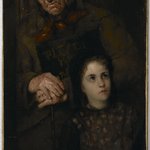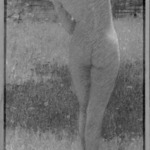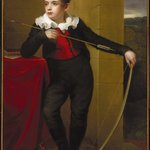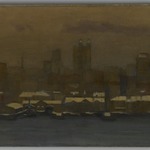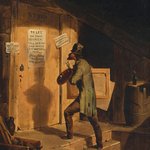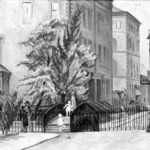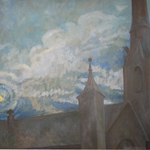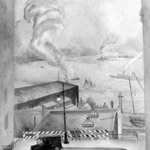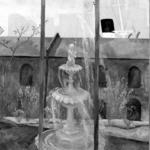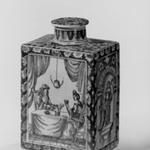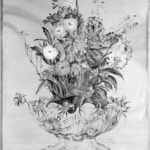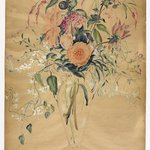
The Emerald Tower
Isabel Lydia Whitney
American Art
Modernizing the Urban Landscape
By the late 1920s, signs of modernization and industrialization were intruding on the residential neighborhood of Brooklyn Heights, where Isabel Lydia Whitney grew up. The Emerald Tower and The Blue Peter are part of a series of works Whitney painted about 1927 of the changing area. Exhibited in 1928, the series was praised for its honest depiction of the American scene and “the poignancy of transition.”
In The Emerald Tower, the iconic Brooklyn Bridge is relegated to the far distance, and the painting is dominated instead by the new Squibb building, part of a manufacturing plant for a pharmaceutical company. The masts, smokestacks, and rigging seen in The Blue Peter hint at the encroachment of waterfront commerce.
By the late 1920s, signs of modernization and industrialization were intruding on the residential neighborhood of Brooklyn Heights, where Isabel Lydia Whitney grew up. The Emerald Tower and The Blue Peter are part of a series of works Whitney painted about 1927 of the changing area. Exhibited in 1928, the series was praised for its honest depiction of the American scene and “the poignancy of transition.”
In The Emerald Tower, the iconic Brooklyn Bridge is relegated to the far distance, and the painting is dominated instead by the new Squibb building, part of a manufacturing plant for a pharmaceutical company. The masts, smokestacks, and rigging seen in The Blue Peter hint at the encroachment of waterfront commerce.
MEDIUM
Oil on canvas
DATES
1927–1928
DIMENSIONS
24 x 18 in. (61 x 45.7 cm)
Frame: 27 x 21 x 2 in. (68.6 x 53.3 x 5.1 cm) (show scale)



SIGNATURE
Signed lower right: "Isabel Whitney"
COLLECTIONS
American Art
ACCESSION NUMBER
54.18
CREDIT LINE
Gift of Mrs. James H. Hayes
CATALOGUE DESCRIPTION
Brooklyn Heights, circa 1927. Squibb Building at night, lighted by indirect method. Brooklyn Bridge in distance, carrying lighted train. View down Columbia Heights toward Fulton Ferry. Believed to be the first use of indirect lighting in Greater New York. [comments from donor, 1954]
EXHIBITIONS
MUSEUM LOCATION
This item is not on view
CAPTION
Isabel Lydia Whitney (American, 1884–1962). The Emerald Tower, 1927–1928. Oil on canvas, 24 x 18 in. (61 x 45.7 cm). Brooklyn Museum, Gift of Mrs. James H. Hayes, 54.18 (Photo: Brooklyn Museum, 54.18_PS2.jpg)
IMAGE
overall, 54.18_PS2.jpg. Brooklyn Museum photograph, 2009
"CUR" at the beginning of an image file name means that the image was created by a curatorial staff member. These study images may be digital point-and-shoot photographs, when we don\'t yet have high-quality studio photography, or they may be scans of older negatives, slides, or photographic prints, providing historical documentation of the object.
RIGHTS STATEMENT
Orphaned work
After diligent research, the Museum is unable to locate contact information for the artist or artist's estate, or there are no known living heirs.
Copyright for this work may be controlled by the artist, the artist's estate, or other rights holders. A more detailed analysis of its rights history may, however, place it in the public domain.
The Museum does not warrant that the use of this work will not infringe on the rights of third parties. It is your responsibility to determine and satisfy copyright or other use restrictions before copying, transmitting, or making other use of protected items beyond that allowed by "fair use," as such term is understood under the United States Copyright Act.
For further information about copyright, we recommend resources at the United States Library of Congress, Cornell University, Copyright and Cultural Institutions: Guidelines for U.S. Libraries, Archives, and Museums, and Copyright Watch.
For more information about the Museum's rights project, including how rights types are assigned, please see our blog posts on copyright.
If you have any information regarding this work and rights to it, please contact copyright@brooklynmuseum.org.
RECORD COMPLETENESS
Not every record you will find here is complete. More information is available for some works than for others, and some entries have been updated more recently. Records are frequently reviewed and revised, and we welcome any additional information you might have.



